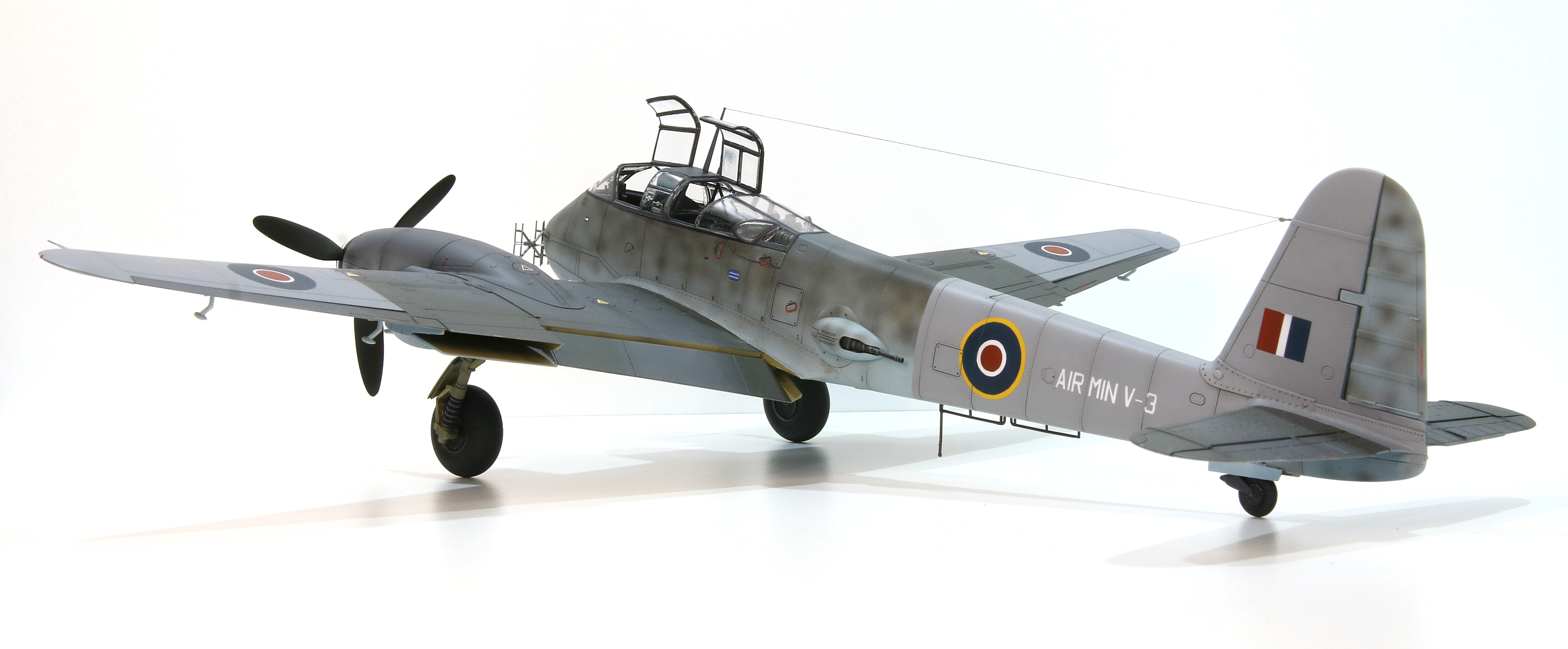
- The RAFwaffe
- The Farnborough ‘Exhibition of German Aircraft and Equipment’
- Meng’s 1/48 Scale Messerschmitt Me410 B-2/U2/R4
- Gallery
- References and Sources
The RAFwaffe
Throughout the war and in its immediate aftermath the RAF acquired several Luftwaffe aircraft, either through capture or even in at least one case, defection. These acquisitions were extremely useful in evaluating the quality of the German aircraft but also the technology driving it. During the war, the aircraft were operated and maintained by No. 1426 Flight RAF and at its end the aircraft were passed on to the Royal Aircraft Establishment in Farnborough, Hampshire.
In October and November the R.A.E. exhibited its collection of captured aeronautical technology at Farnborough. While many of the exhibits had been seen before in regional events, this was the first and only time the entire collection was placed on public display. Noted aviation writer and journalist, Mike Bowyer attended the exhibition and the following is his report; there’s no mistaking his excitement and enthusiasm and it makes for fascinating reading.
The Farnborough ‘Exhibition of German Aircraft and Equipment’

By Mike Bowyer
I knew, as I approached the Royal Aircraft Establishment (RAE), that the event would be memorable. Arrayed for scrutiny was the fruit of victory. Stupendously it became a revelation of incredibly advanced thought and technology influential to this day. No airshow or exhibition has, even remotely, equalled that fabulous Farnborough ‘Exhibition of German Aircraft and Equipment’ held between October 29 and November 11, 1945.
Initially Britain’s latest aircraft were on show – Bristol Brigand MX991, de Havilland Hornet PX237, Hawker Fury NX802, Gloster Meteor IV EE360/G, Fairey Firefly IV Z2118, the superb Martin-Baker MB 5, Fairey Barracuda V and Vickers Armstrong Windsor B.Mk1 bomber. With its four mainwheel layout and complex gunnery system, the bomber was the most unusual of the Britons, none of which generated the fascination and novelty possessed by the Germans. Come now on a tour of the exhibits.
This long-nosed Focke Wulf Fw 190D 210079 (painted in two shades of light grey with pale blue under surfaces and with black ’12’ ahead of the crosses) was in fair condition when I first visited, on November 2. By the end of the second public day, November 11, vandalism had taken its toll.
Balancing alongside is a piloted FZG-76 flying-bomb redesignated Fi 103R and test flown by Hanna Reitsch. Modifications include a 4ft (1.2m) belly skid and primitive eight-instrument cockpit containing a backless wooden seat and crude padded headrest. A stick controls the elevators and ailerons, the throttle is of wood and a button takes care of fuel flow. Frightening to fly, surely, this one was used to ascertain the V-1’s ideal operating speeds. Beyond the Fi 156C CV/2008 and an Bf 109B is ‘AIR MIN 111’, a dark green-blue-brown/light blue Fw 190F-8/R15 whose long travel tail wheel leg raises the aircraft to allow belly torpedo carriage. A clear, ‘bulged’, canopy is featured by the Fw 190F, and that ‘hole in the wing’ allows viewing of a crude torpedo launch angle and flap depression indicator. The Bf 109G-14 alongside is the Central Fighter Establishment’s (CFE VD358 ‘EA-2’ – lettering yellow – carrying prominent D-Day stripes beneath the wings.

Now for the first really interesting item, a pale grey and blue Focke Wulf Ta 152H-1. Once flown by JG301, 150168 now ‘AIR MIN 11’ was intended for high-altitude operations as its 47ft 6in/253 sq ft (14.4m/23.5m²) very high aspect ratio wing indicates. Gone is the BMW 801 of the Fw 190; in its place an annular cowled inline 1,700hp Jumo 213E with huge supercharger intake. Aided by GM-1 nitrous-oxide injection the Ta 152H could attain over 472mph (760km/h) at 41,000ft (12,500m) and reach 48,550ft (14,800m) – very impressive.
Remember wartime photos of twin-boom Focke Wulf Fw 189 Owls, always seeming to have been taken in Russia or around the Mediterranean? At last it is possible not only to find one, but to actually touch it, in this case an Fw 189A-3, AIR MIN 7. Surprisingly large, it spans 60ft (18m) and has been included for consideration of the twin-boom layout and excellent view from the central nacelle.
How the Germans wished they had Mosquitoes and this He 219 prototype VII 310189, rebuilt as an A-5/R2, is an attempted antidote. With an astonishingly slender fuselage, wings, tail, annular cowled DB603G engines and very light grey finish with darker stipples on the upper surfaces, its 33,000lb (15,000kg) all-up weight means it is underpowered. Maximum speed is about 365mph (587km/h) at 19,700ft (6,000m). The crew of two enter through the top of the cabin, to sit in compressed air-operated ejector seats; the first in operational use. The white ‘AIR MINISTRY 22’ identity is hard to detect.
The outstanding Arado Ar 234B-2, of which VK877/AIR MIN 26 is an example of the world’s first operational photo-reconnaissance jet, several of which, and possibly this one used by 1.(F)/33, ventured over East Anglia in the latter part of the war. Finish is excellent; the view from the much glazed cabin superb. Note the centrally sited blind flying panel with other instruments flanking it, the closely cowled axial flow Jumo 004-B3 turbines, and camera in the rear fuselage; it even features a braking parachute. The Me 262A-1 is represented by this example used by I/JG 7. Farnborough flying suggests a top speed of 540mph (869km/h) at 19,685ft (6,000m), a ceiling approaching 40,000ft (12,192m) and possibly 95 minutes operational endurance. German records list a climb to 26,240ft (7,998m) taking 11 minutes and a take-off run of 1,090 yards (997m). A broad blue band aft with a red one to its rear encircle the unusual triangular cross section fuselage of ‘AIR MIN 80’ which displays 119610 on its fin.
Altogether different is this ingenious hefty twin-engined fighter, the business-like Do 335A-12 driven by pusher and puller 1,700hp DB-603A annular cowled engines. The front propeller incorporates reverse pitch to shorten the landing run, and ejector seats are fitted. An incredible speed of 455mph (732km/h) at 23,300ft (7,100m) is claimed for the single-seater making it the world’s fastest piston-engined fighter. This, though, is a two-seat trainer version able to reach 430mph (692km/h) at 17,700ft (5,395m). The wings are detachable in entirety at their roots for easy transport. One of a group captured by the US 9th Army at Dornier’s Oberpaffenhoffen works, it hides its 240112 individual identity internally.

This ex-I/NJG 3 Bf 110G-4 night fighter, ‘AIR MINISTRY 30’/730037 carries FuG 202 radar and very large exhaust flame dampers. A rarer sight is the pale grey and blue Me 410B-6 ‘AIR MINSITRY V3’, a maritime strike fighter carrying small nose radar aerials associated with FuG 200.
One of the most important Luftwaffe aircraft captured during the war was the Ju 88G-1 night fighter, 4R+UR/712273, which its pilot landed at Woodbridge, in error, on July 13, 1944. Siebel Si 204D-1 AM4, BU+PP, unusually carrying an extensive array of nose aerials, was used as a radar trainer – as you can see from its tightly packed contents.
Wartime tales of Mistel composite aircraft were, to say the least, lurid. Strong rumours spread after one exploded near Andover in the summer of 1944. This Mistel combination consists of pale coloured Fw 190A 733759//AIR MIN 77 controller attached to the dark and light green (with black snake lines) time-expired Ju 88A ‘2492/AIR MIN 77’. More novel than awe inspiring, and somehow smaller than expected, it was being used by IV/KG200, the training element of the ‘spooky’ Geschwader.
Can you recall Ju 188s chugging around, sounding like high-speed over-powered Ansons, over Britain from September 1943? Ju 188A-1 AIR MIN 108/230776, powered by Jumo 211s might have been among them. In familiar German style the crew would all work closely together. Guns have gone, but plentiful radio and other equipment makes it cramped and looking unplanned even if the space is greater than in a Ju 88. The nose transparency provides a very good all-round view. Green spinners with white spiralling are unusual, and there are three large areas of black on the upper green camouflage.

An up-market 1,800hp BMW 801TJ powered version of the Ju 188 was the Ju 388 labelled a ‘K’ but more likely an ‘L’ because of its belly extension carrying cameras. Faster and higher flying than a ‘188, it has a two-gun remotely controlled twin MG 131 FA 15 tail turret. A top speed of 382mph (615km/h) at 29,300ft (8,930m) is claimed. This is a development aircraft, 4500006 PE+IF/’AIR MIN 83’ and has very bright blue under surfaces.
No German aircraft display would surely be complete without a Heinkel 111, such an audible unmistakable Luftwaffe wartime item. This specimen, 701152, is an H-20 transport which originally featured a dorsal turret. It wears a smart matt black overall paint scheme. Red letters outlined in white may look strange until one spots the combined ‘OCW’ and ‘HV’ along with ‘Americanised’ roundels and US markings below the wingtip. Captured by the Americans and intended for shipment home, it instead was diverted to the 56th FG, hence the ‘HV’ identity and squadron commander’s initials.
The only other bomber on show, Dornier Do 217M-1 ‘AM106’/56527, is also mainly matt black. Grey mottled areas and ‘snaky’ wave style side camouflage have been added. Over painted and faintly visible on the starboard side are small letters ‘U5’ aft and bold ‘HK’ forward. Early 1944 found the aircraft with I/KG2. With a weapon rack beneath each mainplane, the Do 217M can reach 320mph (515km/h) at 18,000ft (5,486m). Carrying 4,840Ib (2,195kg) load in the 14ft 10in (4.5m) long bomb bay its range is 1,090 miles (1,754km) when cruising at 230mph (370km/h).
Sitting at the controls of the large, curious Arado Ar 232B transport certainly is a rare treat! AIR MIN 17 displays ‘RB’ in black on the port fuselage side and just ‘R’ on the starboard all dating from service with III/KG 200. Defence is vested in a dorsal MG 151; two guns poking from where boom and main body meet, and an MG 131 in the nose. The four-section, plank-like wing spanning 110ft (33m) is certainly very advanced, for it incorporates for good field performance boundary layer control over the trailing sections and flaps. Reduced pressure in the oleo legs allows the aircraft, for loading, to sink close to the ground. Then, a large very low angle ramp is lowered from the rear fuselage; the interior cargo area volume is small when compared with that of a modern transport. Take-off weight is 46,600lb (21,138kg) including 10,000lb (4,536kg) of useful load. The aircraft cruises at 180mp/h (290km/h) at 6,560ft (2,000m) for 565 miles (909km). The ‘flying elephant’ emblem on both sides of the nose is novel. By the way, it had a type name…Hercules!
The next item is a Ju 290A-2 – how many of us wanted to see one of the big Junkers bombers reported over Britain in 1940? And how many, in desperation imagined they could see one? Although it still features a large cargo ramp this is one of only three A-2 reconnaissance bombers which joined FAG.5 at Mont-de-Marsan for Biscay operations, hence the search radar and additional gun turret. Very square in section, the capacious and empty fuselage has sides and roof painted yellow. A turret just aft of the cockpit can mount a 20mm cannon. A yellow band had once encircled the rear fuselage upon which ‘9V’ in small characters had been applied. Aft of the crosses on 110157/ ‘AIR MIN 57’ was a red ‘B’ and a black ‘K’ all linking it with 2/FAG 5.
There is still plenty lots to see, like ‘AIR MIN 109’, a Ju 352 and an advanced relation of ‘auntie 52’. The nose engine pokes snout-like giving an overbalanced appearance to the overall length of 79ft 4in (24m). Very complex exhaust stacking leads fumes clear of the cockpit. Dropping down amidships is yet another sizeable entry ramp settling too steeply at 45° or so. Forward view from the cockpit, especially on the ground and despite lowered side panels, leaves much to be desired for a military transport. On the fuselage ‘RX’ precedes the balkenkreuz and ‘G6’ in small digits is painted aft.
Before leaving the aircraft park we must climb aboard Fw 200C-4, ‘AIR MIN 94’, GC+AE and one-time personal transport of Heinrich Himmler, Head of the Gestapo. Camouflaged dark grey and dark green with light blue under surfaces, and like most German transport having yellow undersides to the cowlings, it retains a forward turret and a Fw 20 gun position at the rear of the belly ‘bath’, for it was built as a bomber. The interior is sombre with high gloss grey painted areas, polished wooden panelling and grey upholstery. For its time, the galley is quite extensive. Seating is for 11 passengers in two compartments, Himmler and four friends occupying one. Try his bullet-proof seat!

The Group ‘A’ indoor exhibits filling ‘A’ Shed are incredible. Confronting us upon entry, Rheinmetall Borsig’s Rheintochter (Rhine Daughter) R1 guided weapon sets the scene. Most futuristic looking, this surface-to-air rocket missile consists of two-stages, solid fuelled. Launched from an inclined ramp, stage one falls away automatically igniting stage two. The warhead is just aft of the 40° swept wings. Radio control is linked to small nose elevators.
Overall the missile is 18ft 10.5in (5.7m) long, attains a speed of up to 1,500 feet-per-second but has limited value because its ceiling is only 20,000ft (6,096m).
Built by Elektromechanische Werke this next missile is a quarter-scale model of their radio-controlled liquid acid and Visol powered ground-to-air anti-aircraft rocket Wasserfall (Waterfall). After vertical launch its radio picks up instructions guiding it to its quarry. The 500lb (227kg) warhead is proximity fused, and the missile can attain 800mph (1,287km/h) and 55,000ft (16,764m). Of over 30 launched, only a dozen performed as intended. The model is 6ft 3.5in (2m) long and 8.5in (21cm) in diameter, so the full-scale rocket was indeed large. In the next group are air-to surface weapons. The battleship grey radio-controlled anti-shipping glider bomb with 1,100lb (500kg) warhead is an Hs 293A. Guidance flares can be fitted, and a 10-second burn propulsion unit fits below the bomb. It’s amazing that the Germans had this flying by late 1940. Alongside is ‘Fritz X’ a 3,090Ib (1,400kg) armour-piercing bomb fitted with four short wings.

The most curious-looking missile is the radio-controlled, red-painted 4ft (1.2m) long Hs 298. It’s an air-to-air proximity fused guided weapon for air launch against bomber formations from up to a mile away.
Suspended above is a quite remarkable 1,600lb (726kg) Bv 246 unpowered glider bomb. Launched from high altitude it was designed to silently cruise for over 100 miles (160km).
To test smaller rocket weapons slave workers were forced to excavate underground tunnels, one 1,300ft (400m) long tapering from 24ft (7m) to 16ft (5m) in diameter at Volkenrode, where this Feuerlillie 25 was found.
One will surely marvel long at the advanced nature of all those, and certainly of the V-2 rocket over there. The ‘Scuds’ of future Desert Storm showed very little advance over the V-2, and none over its planned derivatives. It would have taken many days just to fully examine this part of the exhibition. V-2 No 24061 – we recently saw 21100 exhibited in Trafalgar Square – was sectioned so that its complexity was fully revealed. At full power, giving 8g acceleration (or 5,000fps), its motor produces the equivalent of 600,000hp, a typical flight lasting five minutes and covering a ground track of between 180 and 220 miles (290 and 350km).
Its simpler cousin, the V-1 flying bomb, is set here in the finest FZG-76 exposure ever likely to appear. 112846 fully cutaway reveals its larger fuel tanks and proportionally smaller warhead. Such changes controlled range. Some V-1s had a clockwork device altering course up to 90°. The ‘caption boards’ are excellent – look at that amazing map showing ramp orientation of French launch sites and likely track lengths. There is so much to fascinate.
In ‘A’ Shed aircraft take second place. There are two He 162 A-1s AM66/120091 and AM64/120097, Fw 190A-4 171747 for undercarriage retraction, a Focke Achgellis Fa 330 unpowered rotor kite, Ju 88G-6 ‘AIR MIN 31’, Bf 109G-14 and an Me163B 191912.
There are also very different items including a three-man delivery container and a 2,160lb (980kg) Type G luftminen or air mine with fins instead of a parachute. Parts of the mine are uniquely made of Bakelite.
The wooden tail-less glossy cellulose finished glider is LA+AC, the Horten IV. The pilot lies prone beneath a humped canopy.
Time is racing by fast and there’s still so much to see including another giant, high-altitude, single-seat fighter, with 66ft (20m) span wings of aspect ratio 12, and a 35ft (10.6m) long fuselage. This, the second and incomplete Blohm and Voss Bv 155B, is powered by a 1,410hp DB603U with a two-stage TKL 15 turbo-supercharger.
There’s insufficient time to visit Static Group B displaying engines and instruments. Included are the DB-601 and 603, and the coupled DB605s which, through a massive plain spur drive, produced the DB610A coupled engine for the He 177. Guns, turrets, bombs, radio, radar, all are there with experts to explain the details. A feast, an absolute joy!
Just time for a last look across the field. Racing across, here comes an Me 410A sounding like a de-rated P-47… “The Exhibition closes today at 4pm”… and Fi 156 AM99 rises and falls, rises and falls along the runway. There’s another Do 217M over there, and another Me 410, and – is JT928 a Dauntless wearing US Navy blue? Beyond is another Ju 352, Fw 190A-4 ‘EA-4’. a Bücker Bu 180, another Fw 190D, two more Fi 156s and the lovely pale blue Savoia-Marchetti SM 95. “The Exhibition closes in five minutes. Please make your way….” and I did, for the third time, relieved to know that some items were to be shown in South Kensington’s Science Museum early in 1946.
Mike Bowyer, 1945
Meng’s 1/48 Scale Messerschmitt Me410 B-2/U2/R4

Build
As this was my first Meng kit I was curious as to how it would go together. I was very happy to find that it went together very well indeed. Assembly began with the very detailed cockpit which I spent some time on to try and do it justice. The parts themselves were very well moulded and the fit was precise.
The airframe I was building had had its forward-firing machine guns removed so didn’t need to spend much time on the weapons bay. I did put a fillet over the forward gun hatch so ensure that I could fill any gaps as may appear later, one it was installed. That came back to bite me, later.
I wanted to paint prior to attaching the wings, and in dry fitting them I found the starboard wing fit required some surgery to the fuselage to get it close. I think this requirement was more my error in assembly rather than the fault of the kit.
Click on any of the images below to scroll through the gallery.


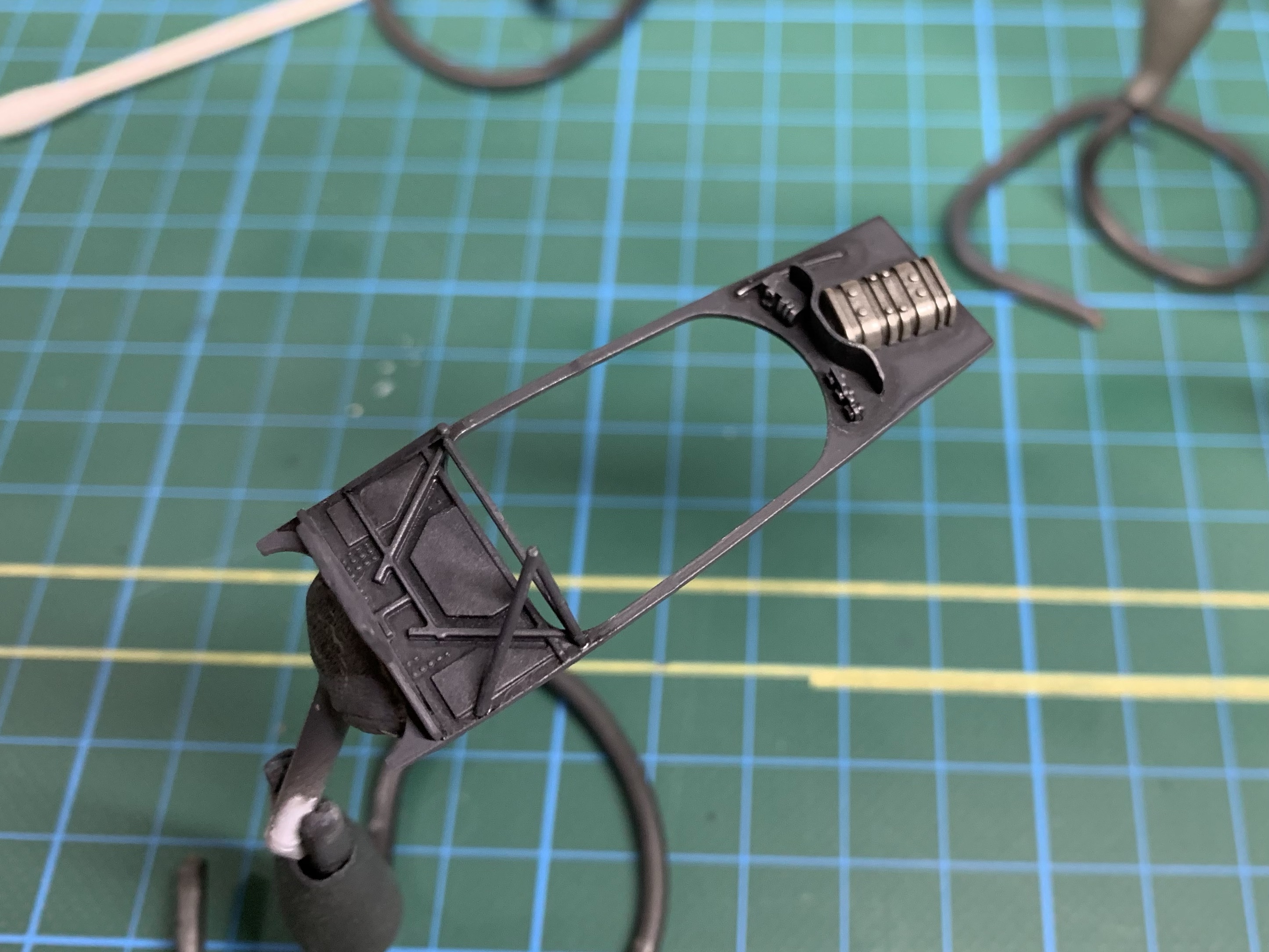


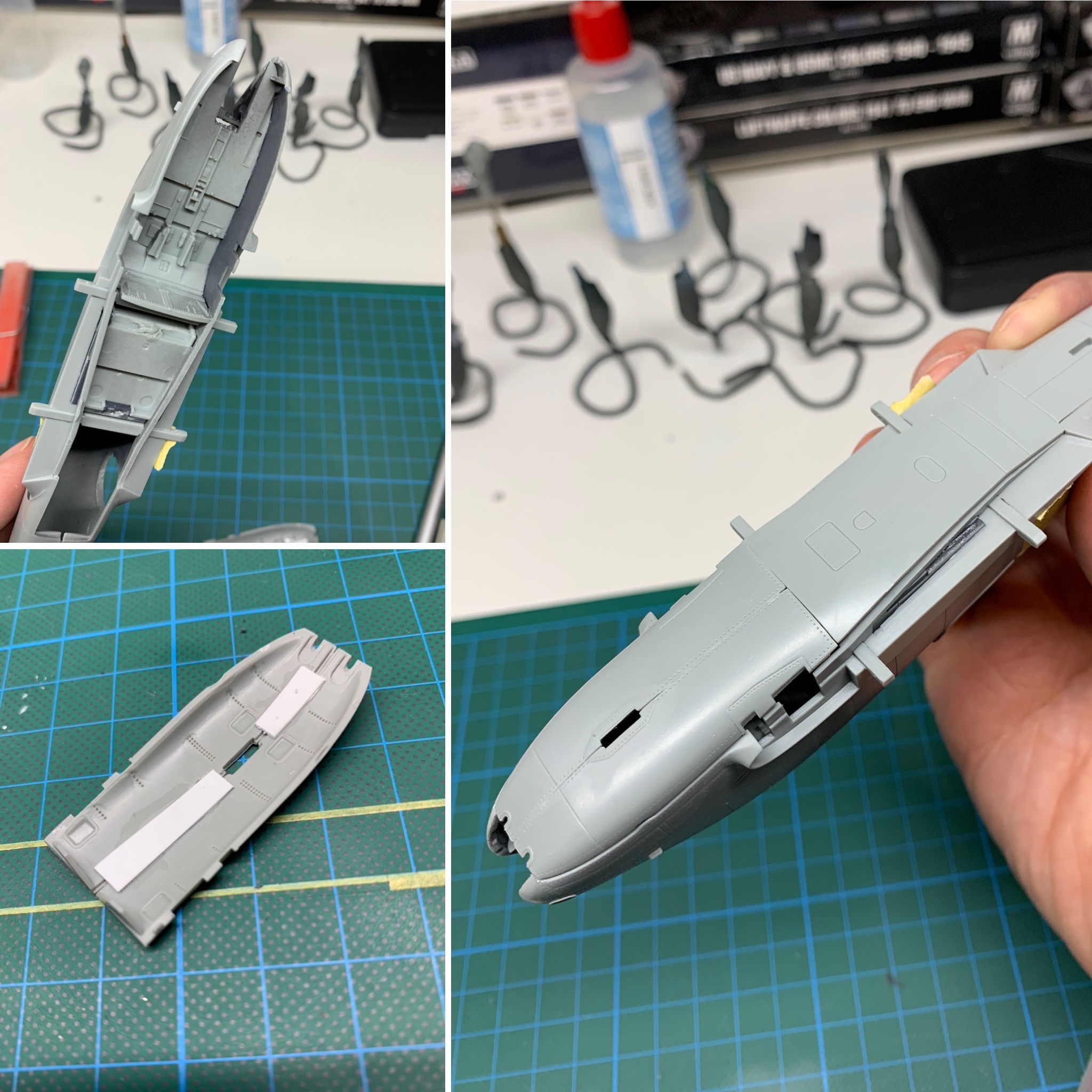



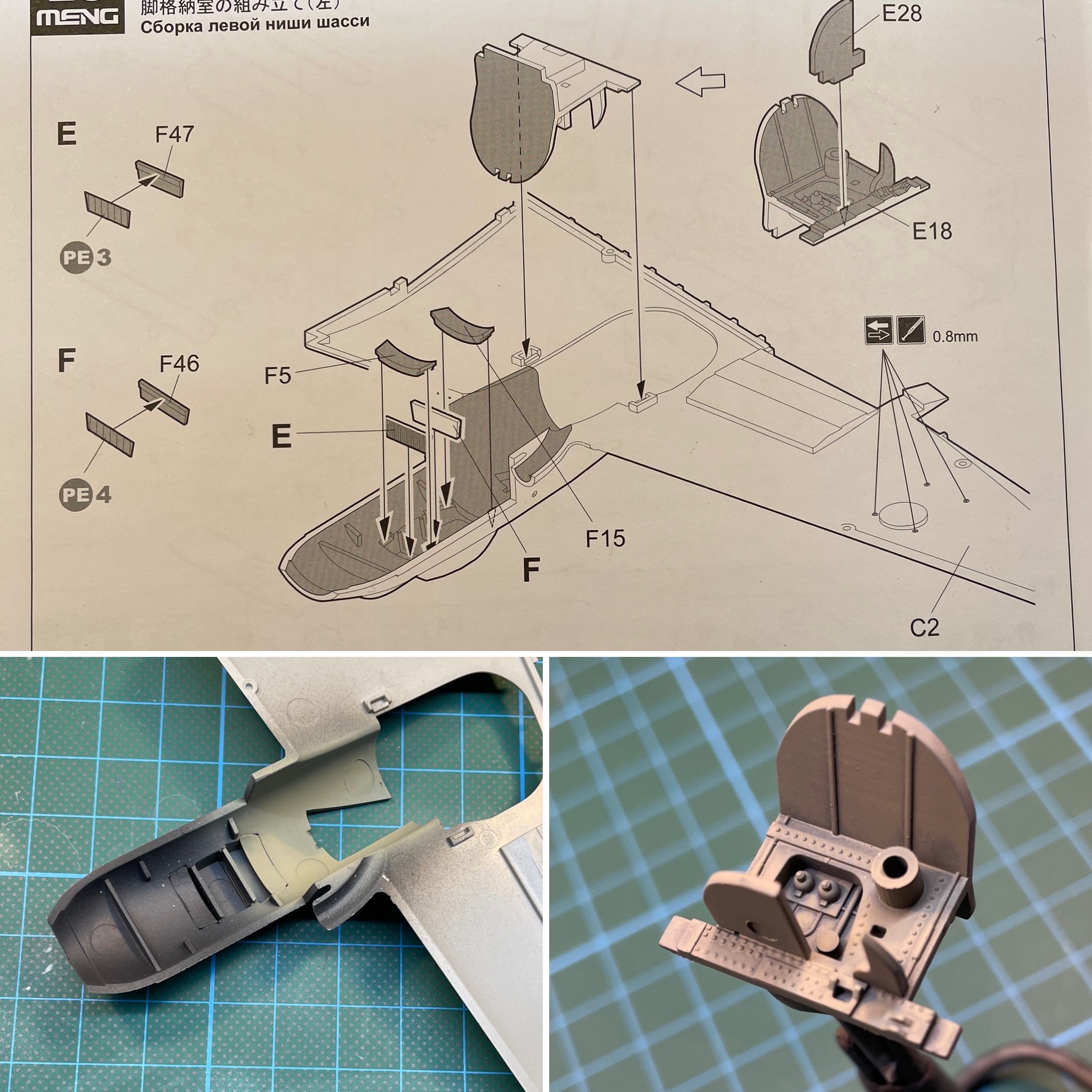

The wings were nicely detailed with separate control surfaces, including the flaps. The kit also provides for nicely detailed engines which can be displayed with open cowlings. I don’t like to display like that but I did paint the engines in case they could be seen, and to see how they would look under paint anyway.
After attaching the canopy I finished the paint prep, cleaned some small seam issues and re-scribed as required. The kit built up very well, I hope this is typical of Meng kits.
Paint
References on my chosen airframe are fairly limited. The photos below were the only ones I could find. The two close-in shots are widely available on the internet, the third I dug up when looking for general images of the the so-called RAFwaffe.
Click on any of the images below to scroll through the gallery.



As is clear, this Me410 was painted in standard 74/75/76 colours in a relatively standard pattern. While it’s very difficult to be clear on the upper surfaces there is no reason to think it is other than the standard splinter style pattern of RLM 74/75. The underside is clearly RLM76. The mottle appears to be quite lightly applied, and extends to the medial line of the fuselage. While light in application, it does seem to be quite widely applied however, with a lot of overspray leading to an almost faded effect.
To aid in deciding how to apply it, I went to some photos I took of what is believed to be the only Me109 still in its original paint. This airframe, belonging to the Australian War Memorial’s collection was available for close-up inspection in 2022 at one of the AWM’s infrequent open days at its storage facility.
Click on any of the images below to scroll through the gallery.


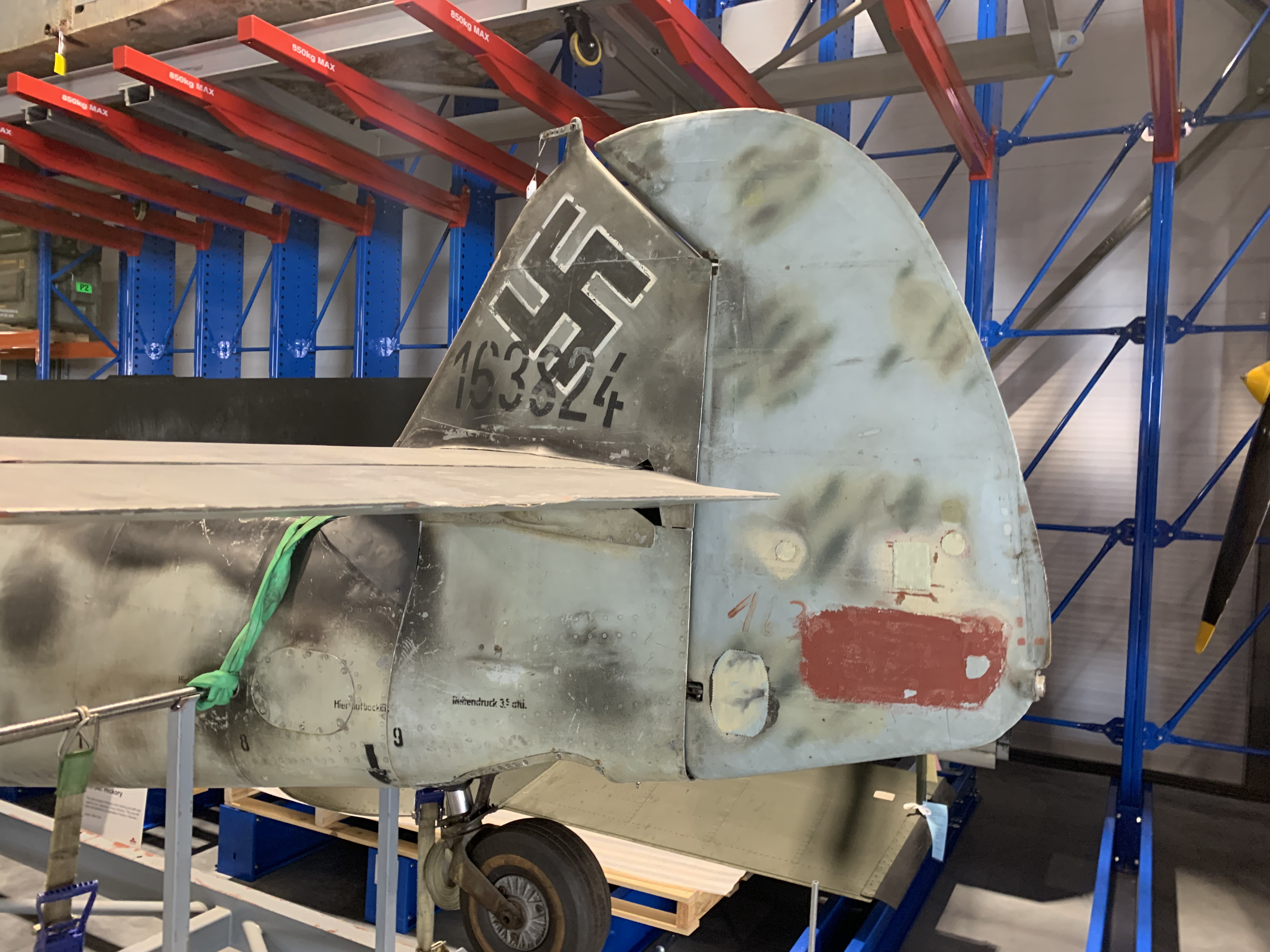



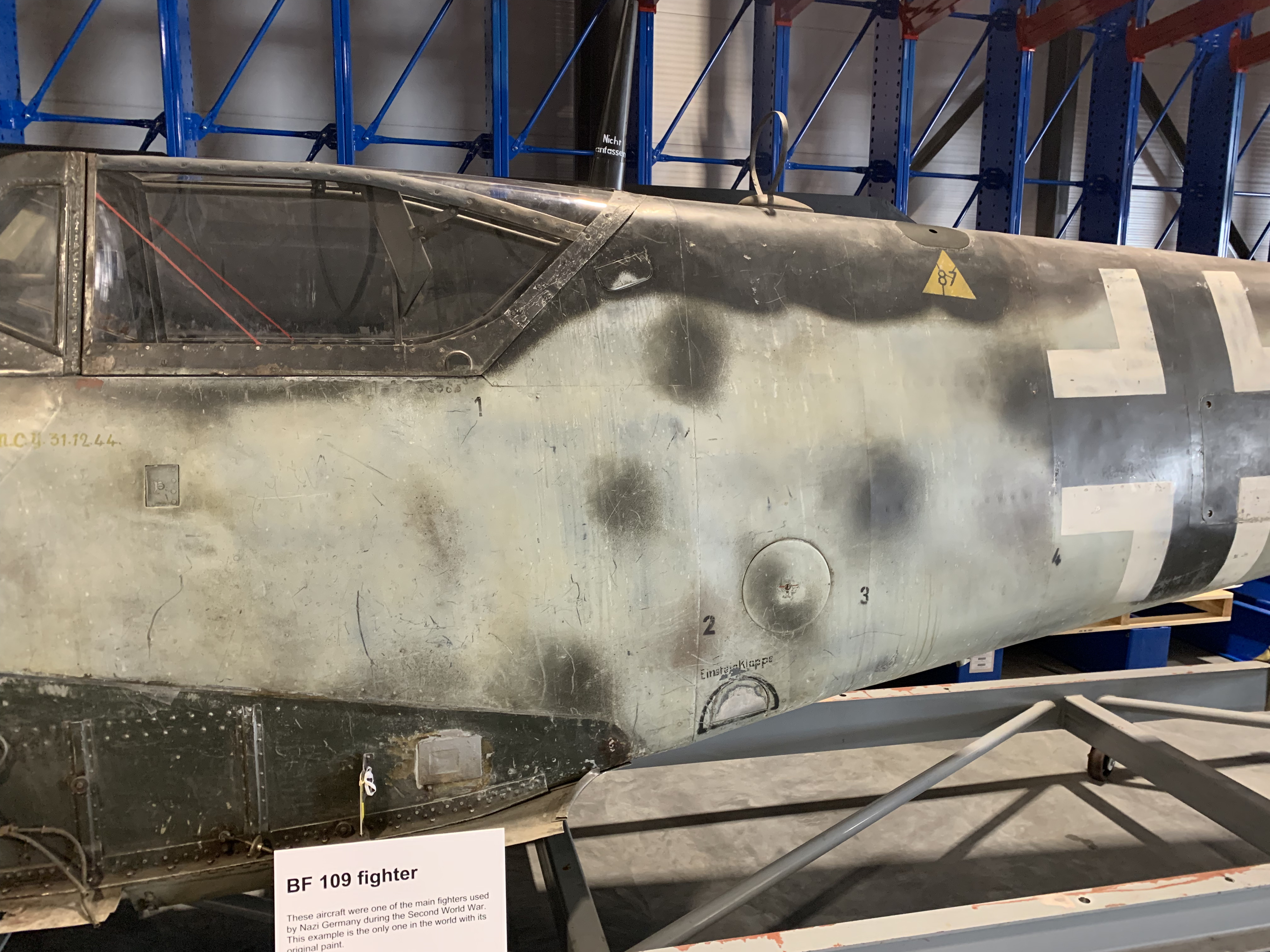

The application of the top colours and the mottle was of particular interest to me on this one, as I wanted to try and replicate it on the 410. I find that we modellers can tend to over estimate the care with which the motel in particular was applied. In the photos above I see the mottle applied quite carelessly and with a lot of overspray. This application differed to my subject however in that the mottle was relatively sparse and quite distinct in its application further reinforcing that there is no standard application!
Coupling the photos of the 410 with those of the 109 I planned to apply a very broad pattern of varying intensity for the mottle. As for the upper camo, that would be applied as per standard, with a soft edge between the colours and also coming down the side of the fuselage blending into the mottle itself.
Click on any of the images below to scroll through the gallery.
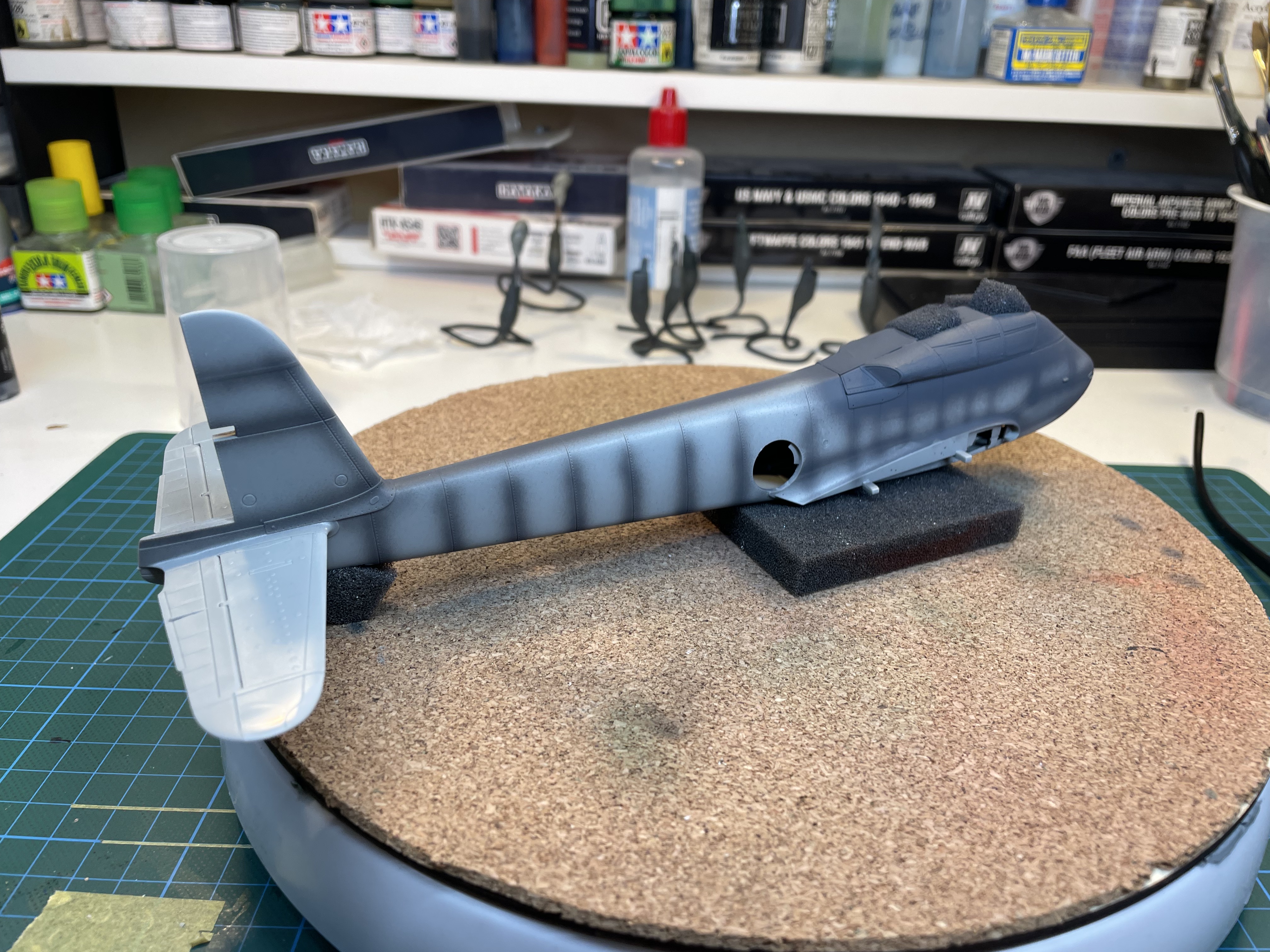
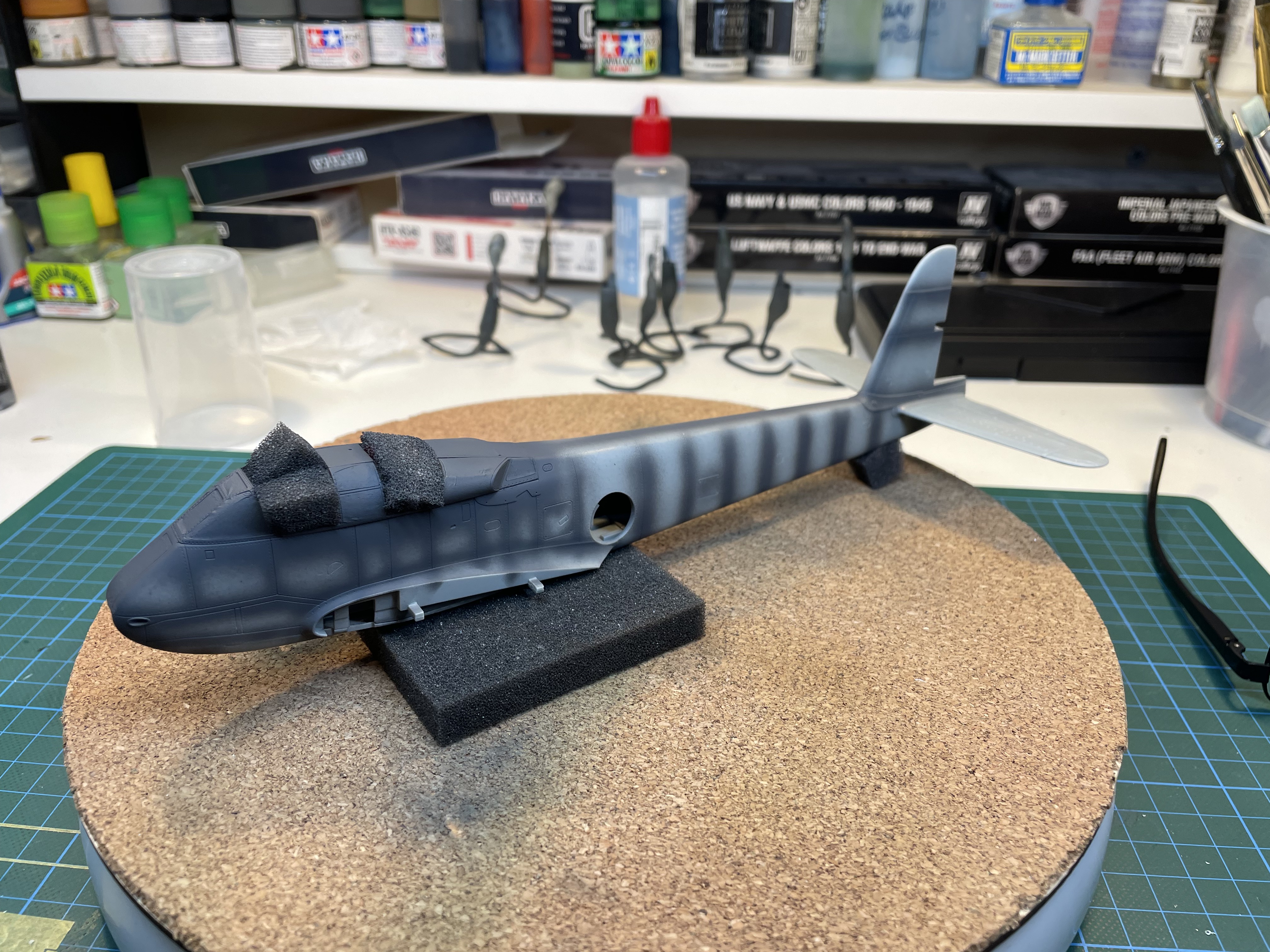




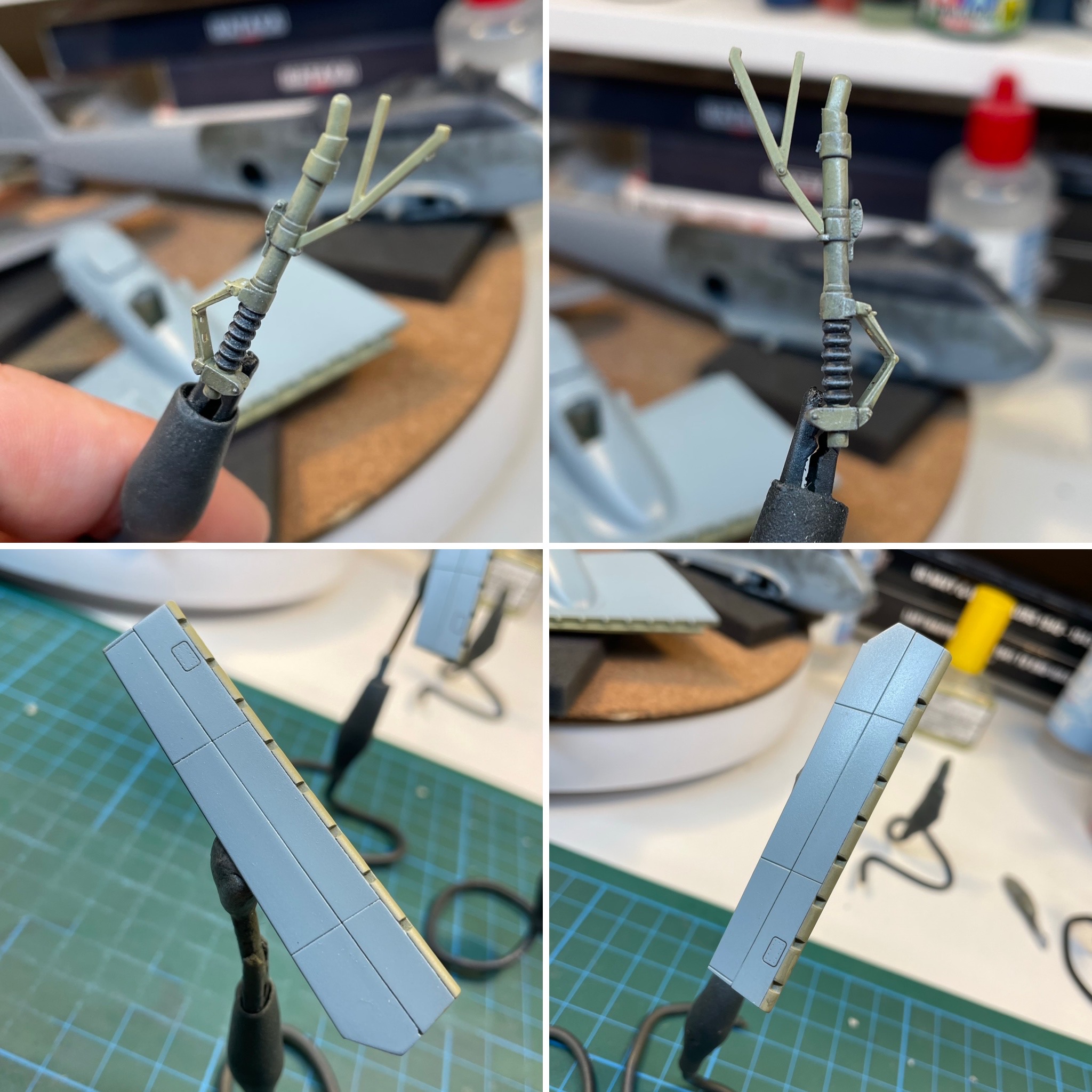



I usual I mixed my own colours using acrylic artist paint for the application. I matched the colours to paint chips saved from various sources and which seem to me a good match compared to, for example, the AWM 109. After what turned out to be a superfluous pre-shade I applied the RLM76 first, and then the upper camo to the horizontal stabilisers first, as well as the fuselage and wings.
Markings
The RAF marked this particular airframe with solid blocks of light grey to cover the Luftwaffe markings before applying the RAF roundels and fin flash. I assumed the light grey used to be Medium Sea Grey. Just visible in the left side photo is the bottom of the fuselage roundel; the yellow ring is visible confirming this to be a Type C1 roundel. I decided on Type C roundels for the wings based on it being post-war and standard on light paint finishes. Visible on the fuselage, but only if I played with the contrast, is some writing. I couldn’t make out exactly what it says but various on-line sources most commonly show it to be “AIR MIN V-3”.



In choosing where exactly to apply the light grey I needed to figure out where it ended on the fuselage and to what extent the grey was painted on the wings. Examining again at the left side image it looks to me that the underside of the wing is painted in a solid block of grey almost to the radiator. Extrapolating that to the upper surface led me to paint the wings grey from wing tip to the end of the aileron. I decided not to paint the aileron grey as the photo might show that it is still in its original RLM76; leaving them in their original colours as I did also adds a little visual image.
I chose to paint the fuselage grey at the panel line as it seemed a logical place to do it, and made masking easier.
With that plan in mind I began to paint. Almost immediately things went a little array. When I began painting I had not yet found the long range photo of the starboard side taken at the Oct/Nov 1945 captured aircraft exhibition. When I did find it, I noticed that the grey was not far enough forward so I added an extension. Easy enough. I also took the opportunity to make the mottling a little denser as that same photo showed the mottle more clearly. The remainder of the grey blocks were easy enough and soon completed.
Click on any of the images below to scroll through the gallery.





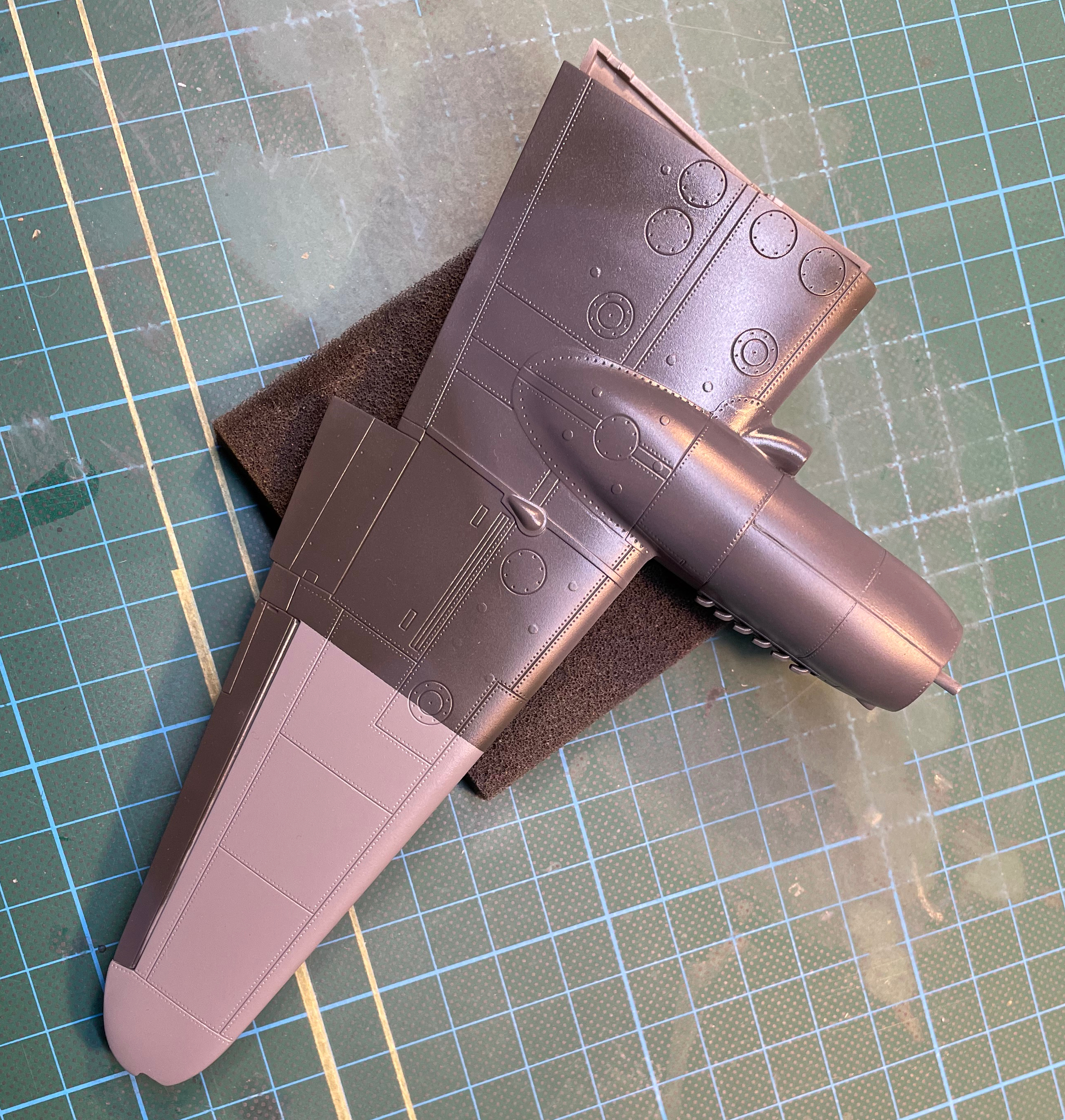
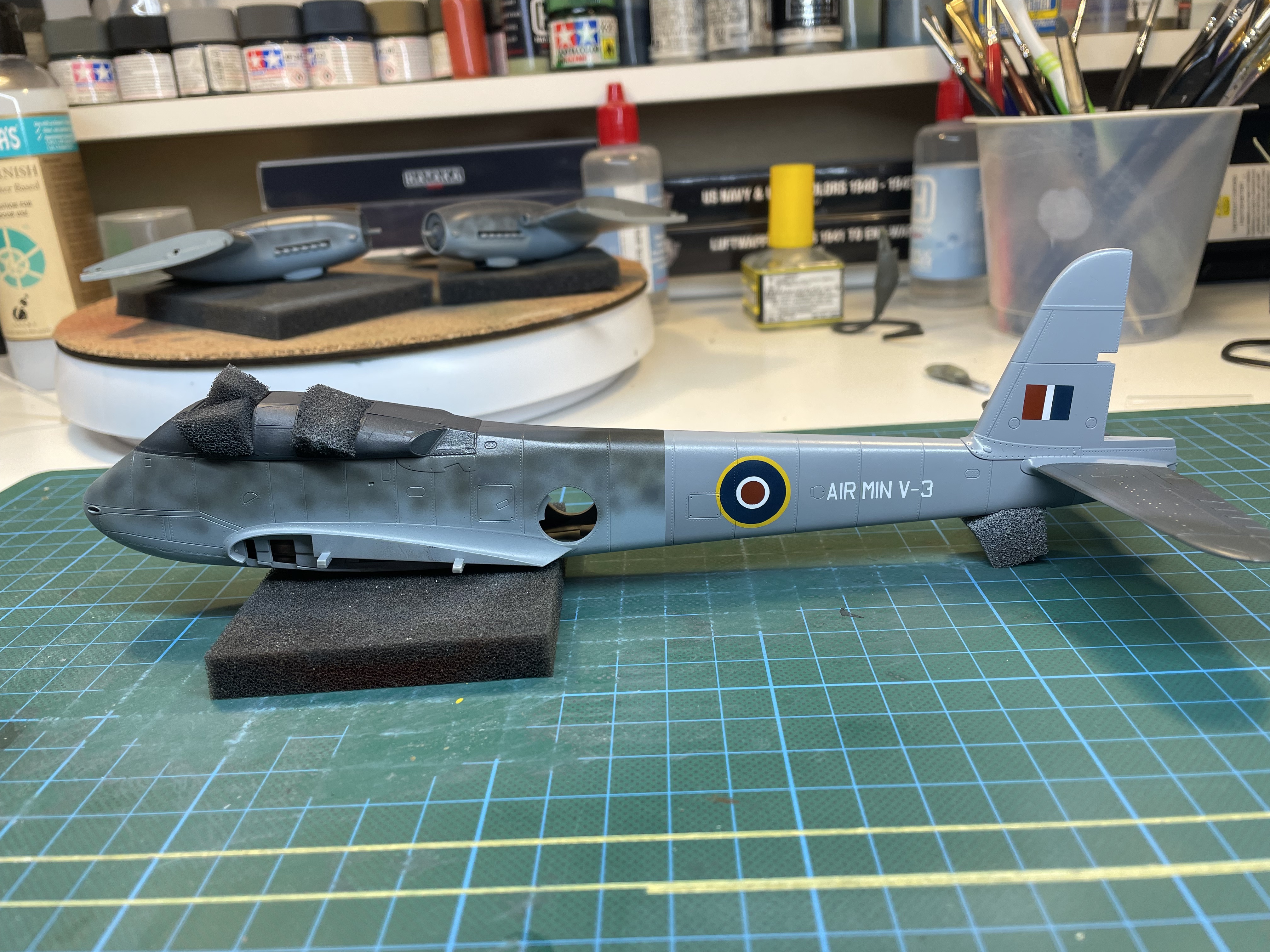




The RAF markings were a simple matter of designing the masks and printing on the Silhouette. There was nothing very difficult about them and nor was there in the painting. I did vary my approach a little inasmuch as while I usually paint roundels from outside in, I applied the yellow last in order to avoid extra masking around the very narrow mask I would need to use had I painted it first.
Once the painting was complete I sealed everything with a clear coat and then used the kit decals for the stencilling.
Weathering
In a general sense I decided that this airframe would likely have been quite clean and well maintained, used as it was for mostly exhibition work rather than flight testing. I did take a look at some images to get an idea of where exhaust staining would occur. The images below showed it to be where one might expect, with the exception of the additional staining on the upper starboard wing.


I began weathering with an experiment in post-shading however, using stained clear gloss instead of thinned paint. My theory here was that I would be able to get a more subtle variation in texture than with paint. The first image in the gallery below shows the result.
Click on any of the images below to scroll through the gallery.






I spent some time on the exhaust shrouds as I wanted to replicate the burnt paint fading to burnt metal transitioning to heat-stained metal. To do this I painted them RLM76, then overpainted the rearmost portions with burnt metal, transitioning to titanium. With that complete I applied some thinned clear orange and then clear blue at the rearmost edge. I liked how it came out, though was a bit of work for a small detail.
The remainder of the weathering was completed as per my normal practise of airbrushing highly thinned paint with some chalk pastel work.
Finish
It’s always a little bit of a gamble leaving the wings off until the final assembly. While I’d taken steps to ensure the fit was a good one, in this case I clearly hadn’t taken enough care as both wing joints had a significant gap at either the upper or lower seam. I doubt this was any fault of the kit, by the way. After checking the dihedral on fitting either the lower or upper seam closed it became clear that – fortunately – it was the lower seam that would be open with the wings attached at the correct angle.
The firts two images in the gallery show how the wings were attached and the seam fixed. I used sheet plastic to fill the gap on both sides and simply trimmed and sanded to flush. I used a little perfect putty wiped into the seam to clean up. Once painted and the join weathered to match the rest of the underside it was very acceptable.
Other notables as I finished off included:
- Extra attention on the wheels – it looked to me like there was a bare metal rim to the wheel so I cut some masks to size and painted them as such
- I masked and painted the spirals on the spinners because the kit decals didn’t work. I didn’t match them perfectly to add a little interest.
- There was some white numbers painted on the starboard propeller spinner which I replicated with white pencil.
Click on any of the images below to scroll through the gallery.



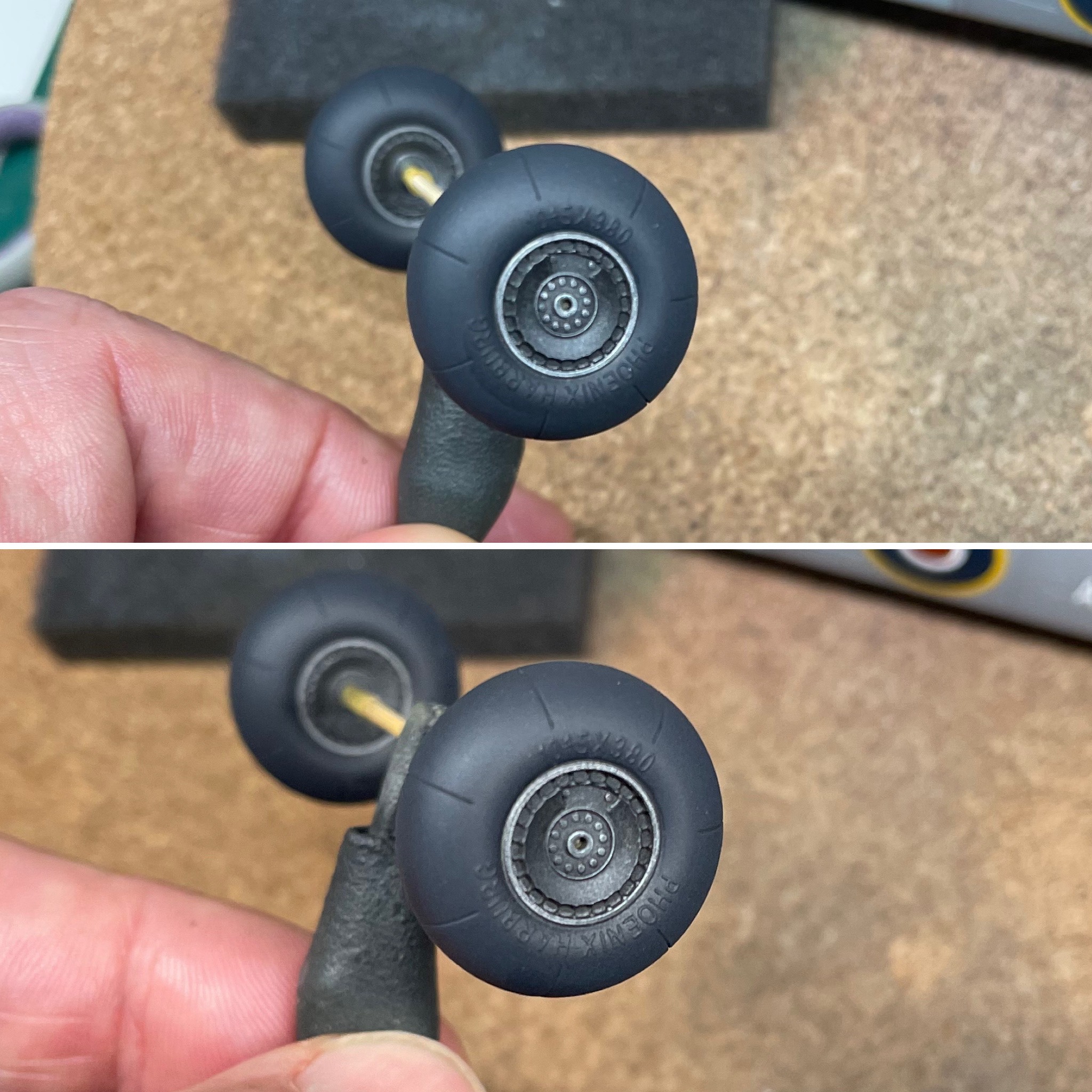

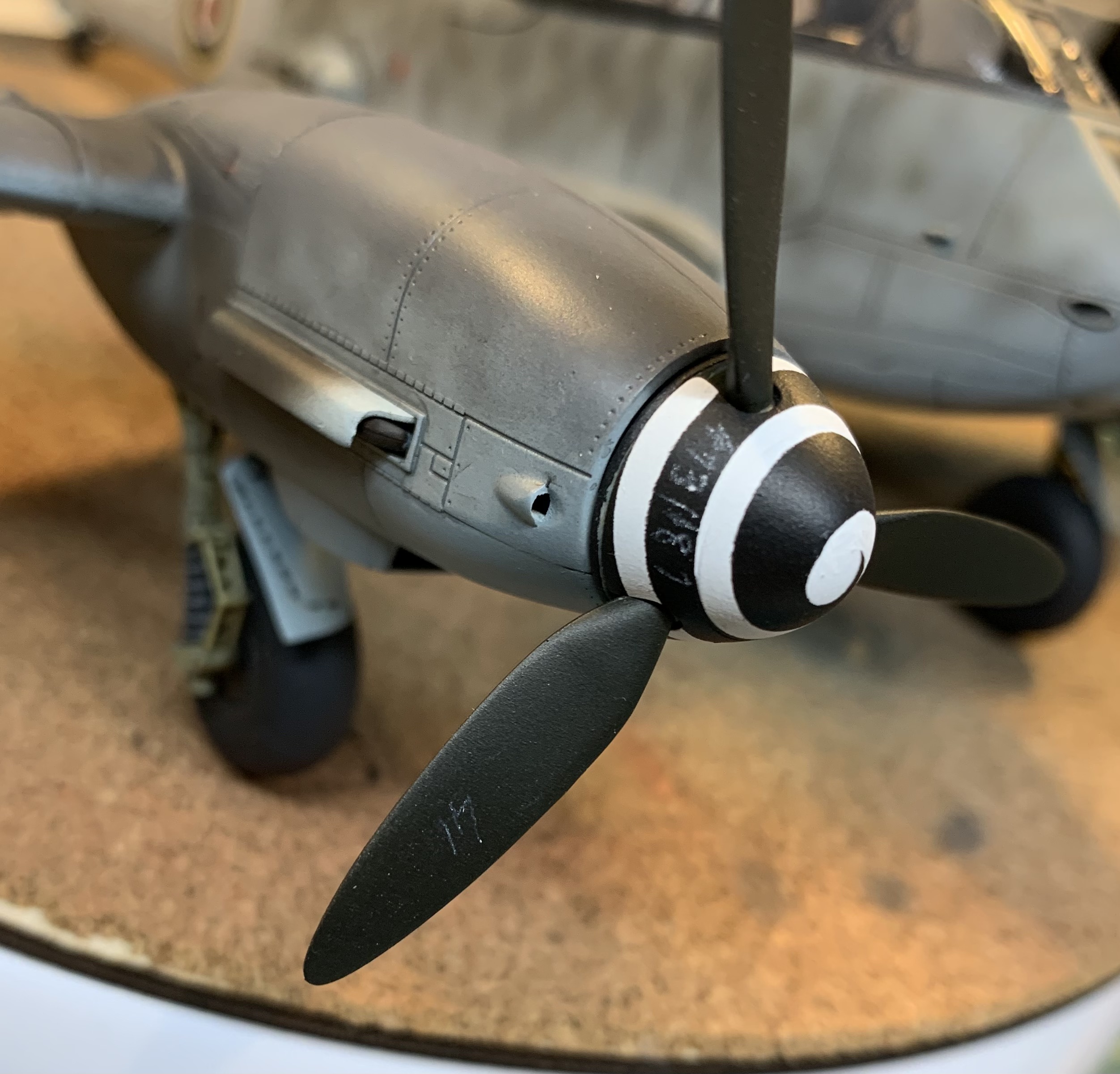



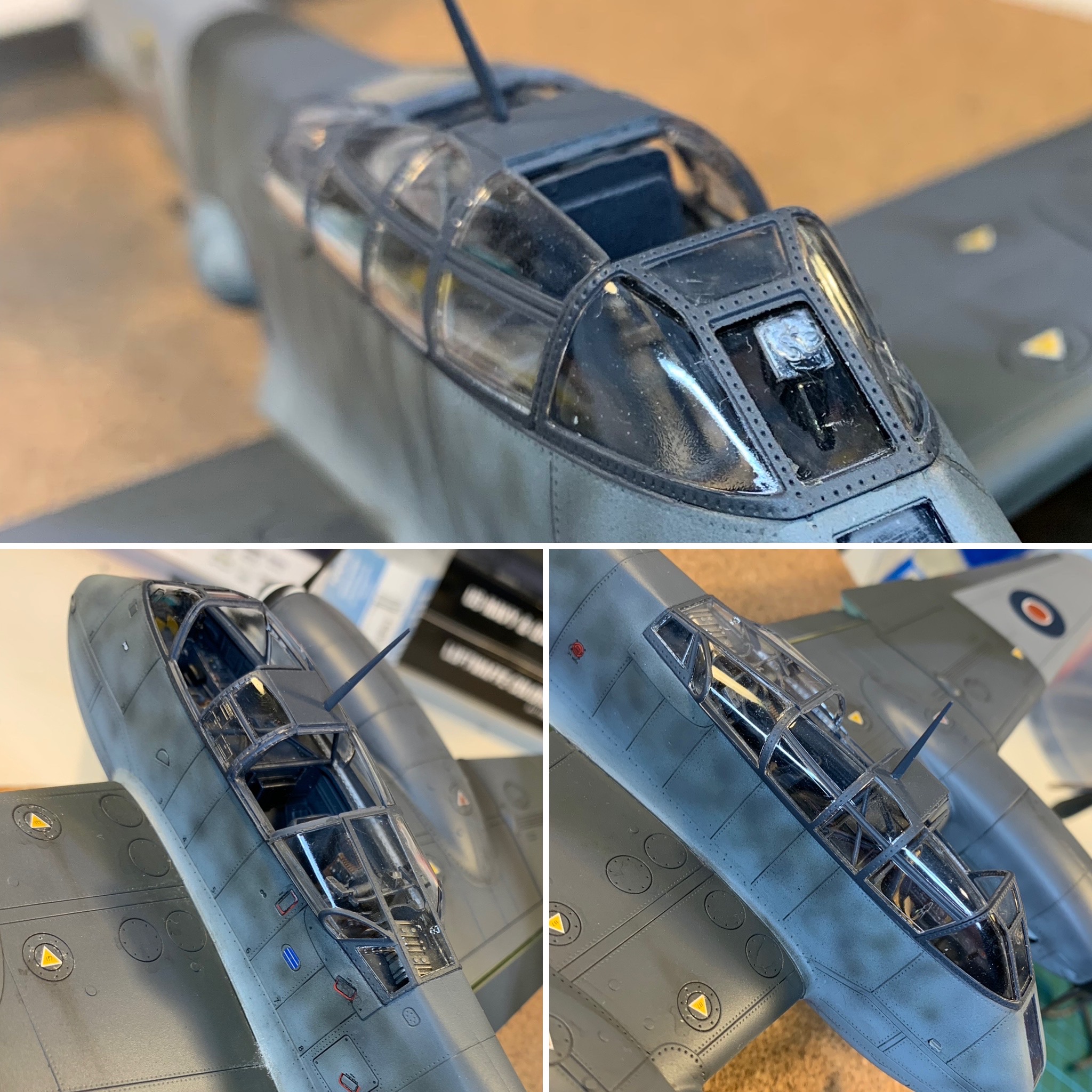

I spent a lot of time on the radar array, most of which was focused on how I was going to mount them. The mounting bracket itself was made from spare thin wire upon which I attached the Gas Patch Fu222 Radar Arrays. I think the mounting bracket came out quite nicely in the end, though it was done on the fly. The arrays themselves were exquisite, even if slightly inaccurate compared to the subject aircraft.
The remaining tasks were the fiddly ones; removing the masking and attaching the undercarriage as well as the antenna post and wire. With typical lack of forethought I had not drilled holes for the wires and so was faced with drilling into the completed paintwork. Fortunately, I the drill bit did not slip.
Summary
My first Meng kit was a satisfying one. I built the ProModeller Me410 many years ago and found that to be a very good kit. This one is better. The quality of moulding coupled with the sensibly clever and appropriately detailed engineering allows for a competent modeller to produce a very nice result. While the DH Mosquito is my favourite twin engined aircraft (I must build more of those, actually), the 410 is a close second. This is a very good model kit of it.
Gallery
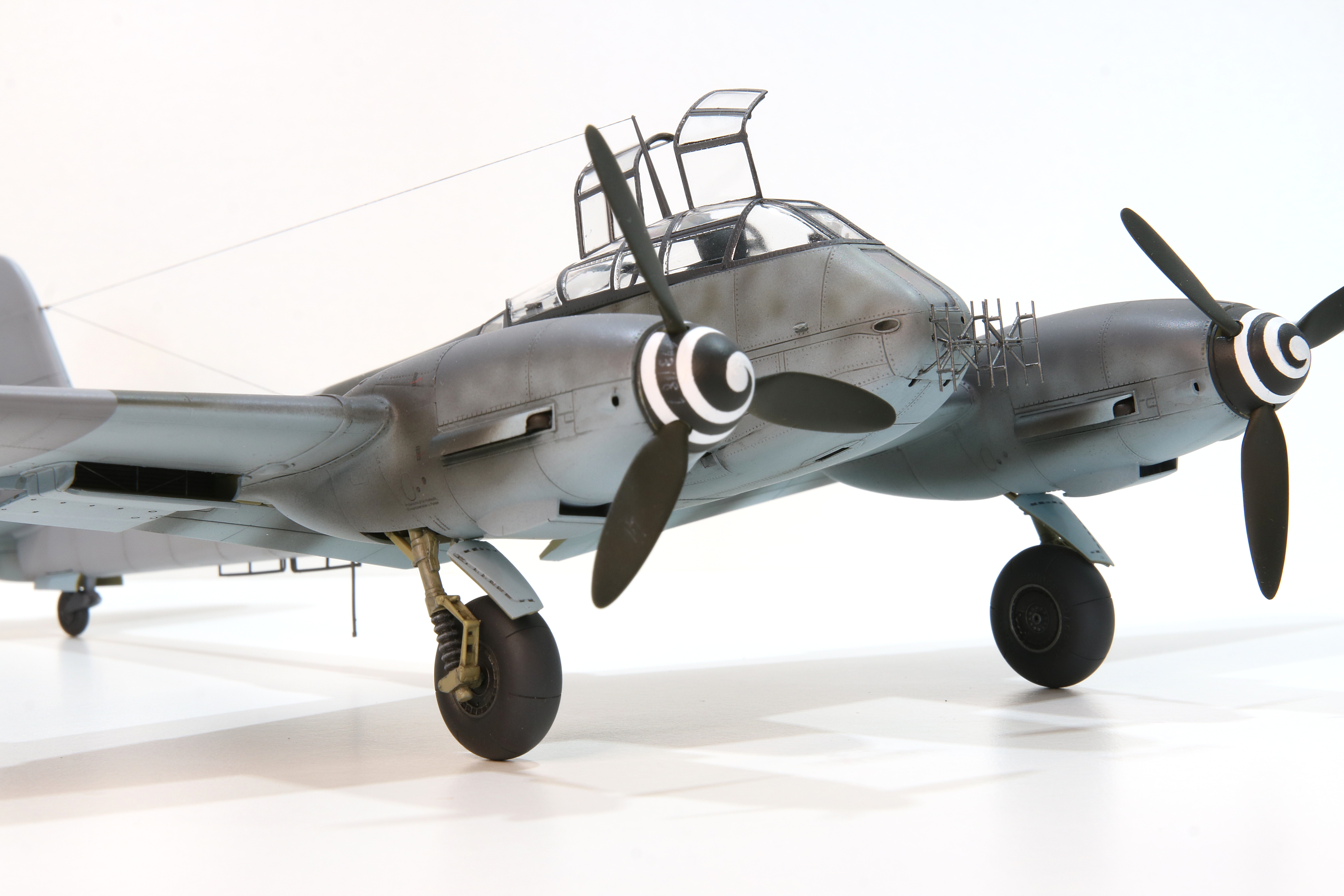

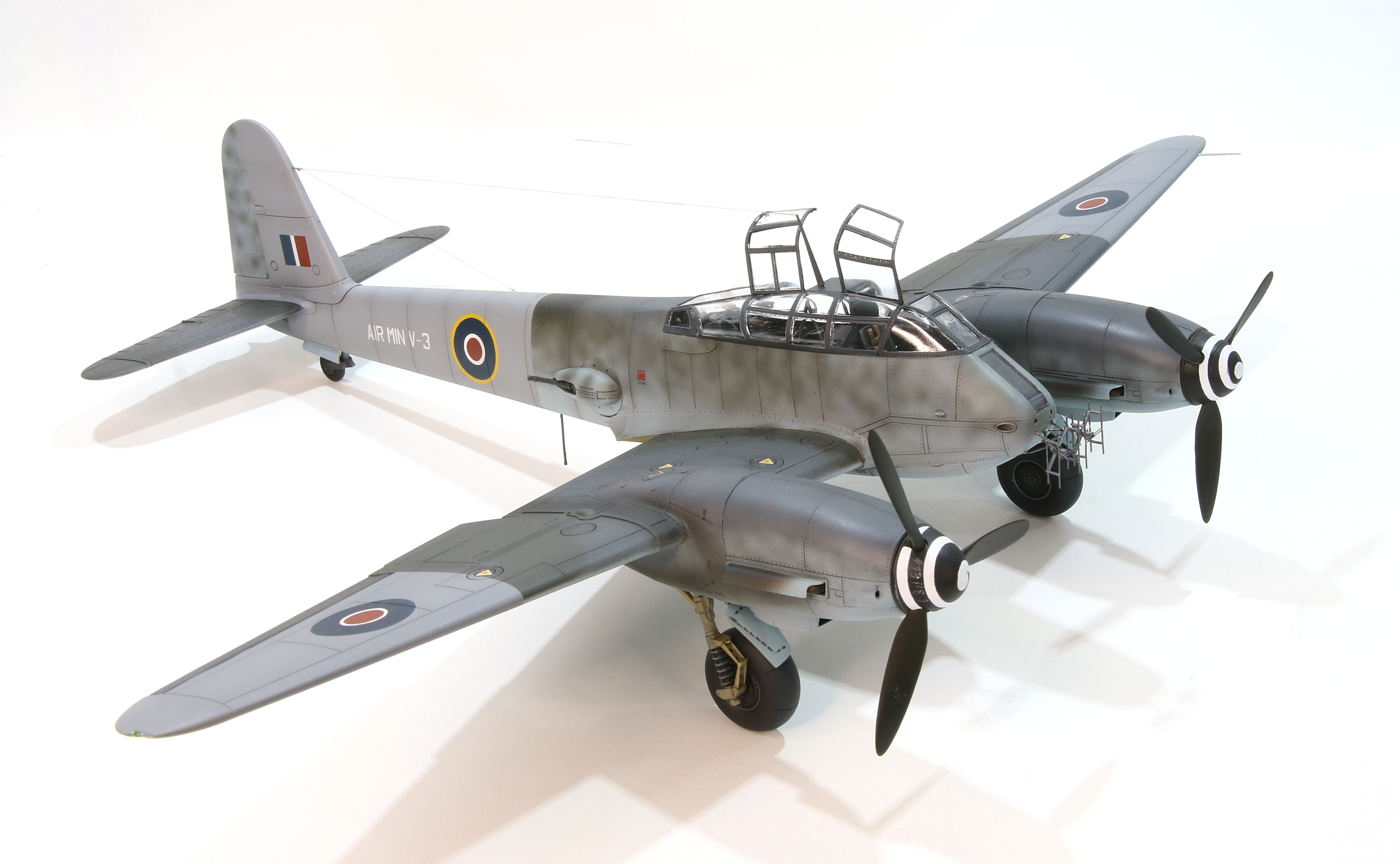

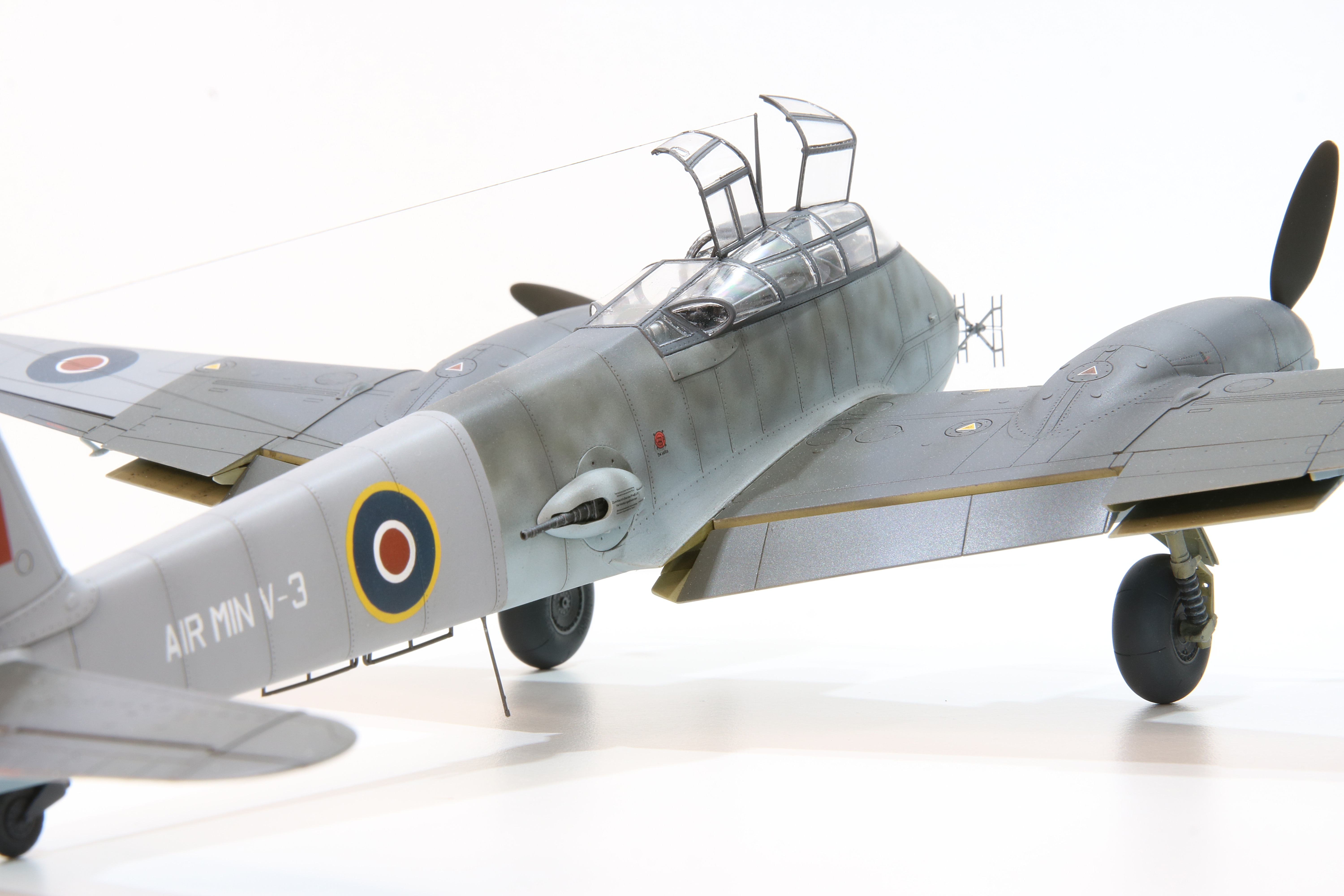
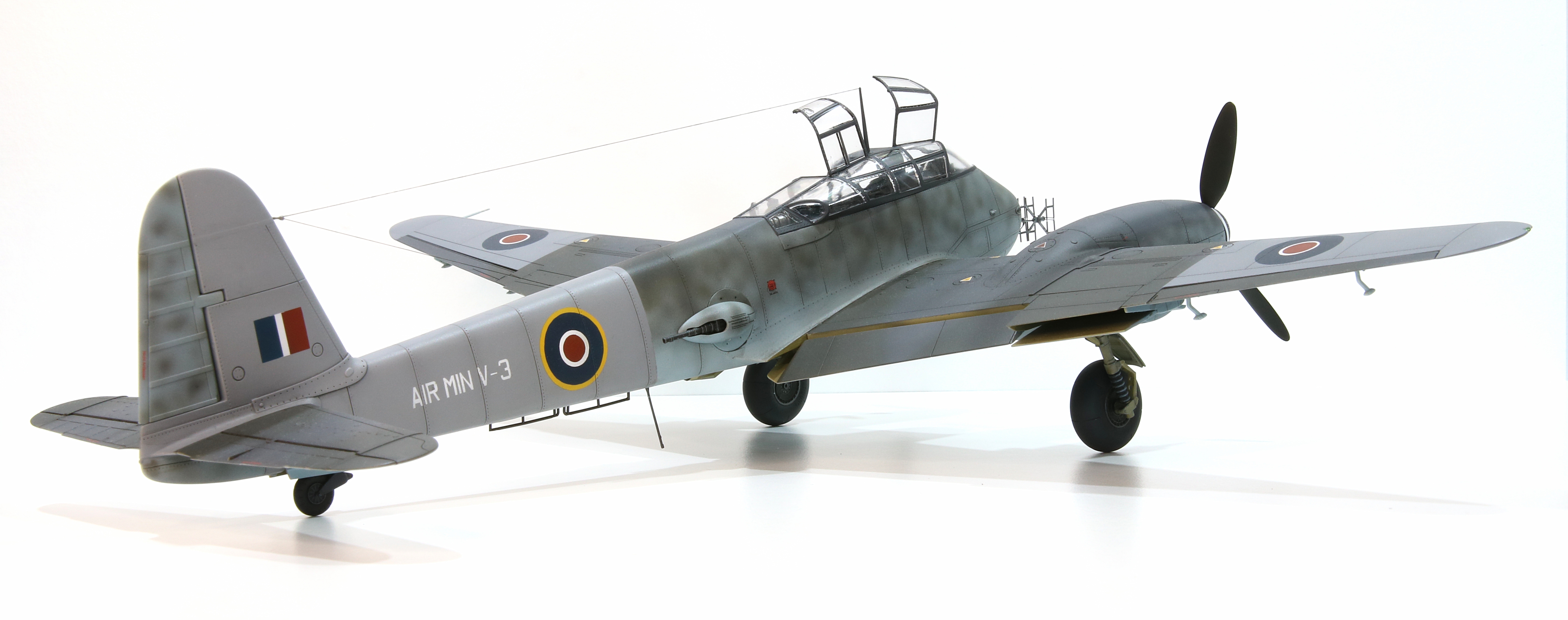








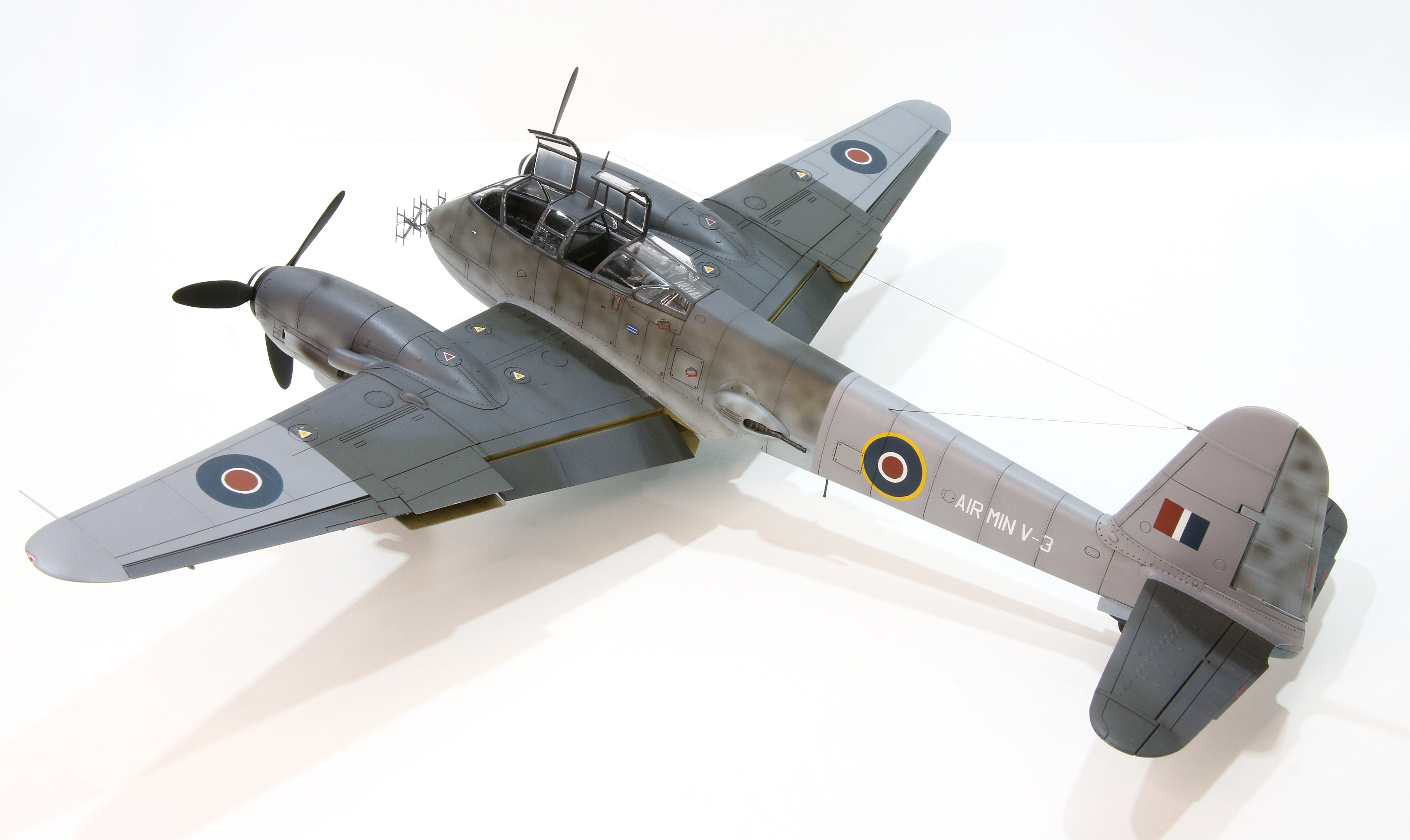



References and Sources
The following websites were useful in completing this project.
- https://falkeeins.blogspot.com/2022/03/captured-enemy-aircraft-at-farnborough.html
- https://www.destinationsjourney.com/historical-military-photographs/messerschmitt-me-410-captured-by-the-uk/
- http://www.indianamilitary.org/FreemanAAF/Aircraft%20-%20German/FE%200499-Me410A2U1/0499.htm
- https://captured-wings.fandom.com/wiki/Category:Messerschmitt_Me_410
- https://www.key.aero/article/luftwaffe-aircraft-display-farnborough
If you are interested in following the build as it unfolded, as well as the research that led to the choice of markings, the full build diary is logged in the Britmodeller Aircraft WIP Section.
Copyright ©2023
This article, its text, and photos of the model is my original work and is protected by copyright in its entirety, except where noted. All research sources are listed in the References and Sources section above, including photos from official sources. All other images and quoted content were sourced from the internet and are used here under protection of fair-use. Any copyrighted content will be happily removed and/or credited forthwith upon request by its rightful owner.
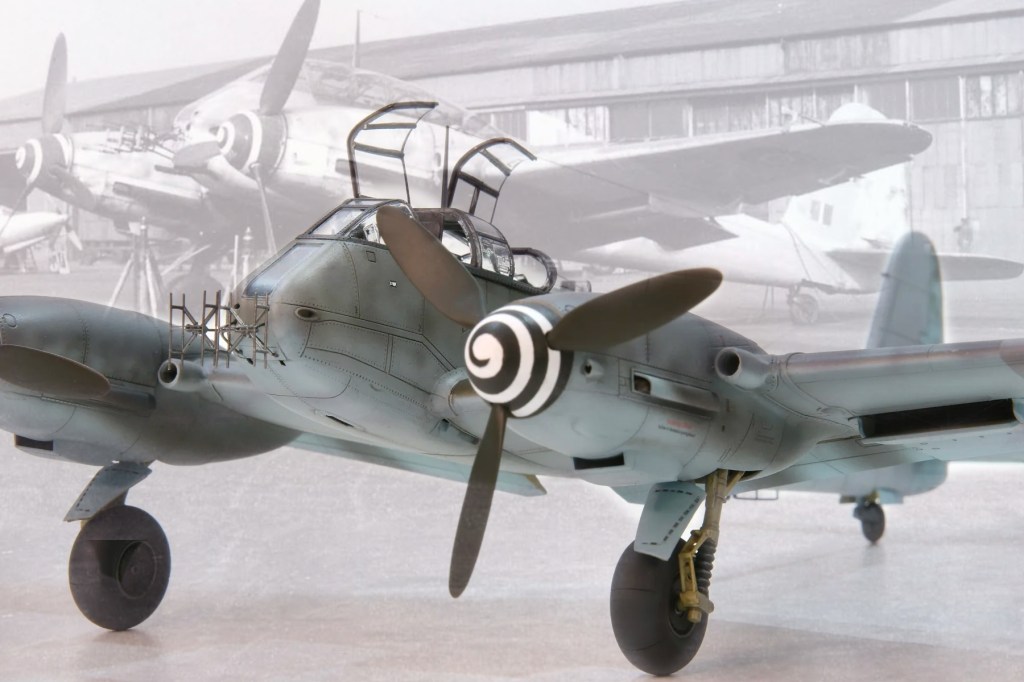
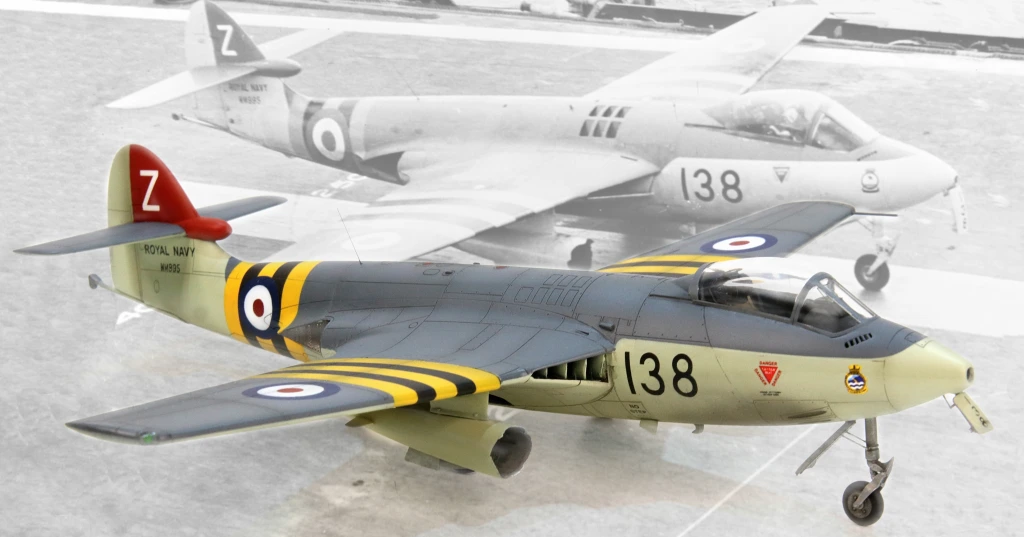



Leave a comment